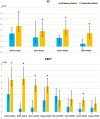Diagnostic accuracy of CBCT versus intraoral imaging for assessment of peri-implant bone defects
- PMID: 33568085
- PMCID: PMC7877020
- DOI: 10.1186/s12880-021-00557-9
Diagnostic accuracy of CBCT versus intraoral imaging for assessment of peri-implant bone defects
Abstract
Background: Early detection of marginal bone loss is vital for treatment planning and prognosis of teeth and implant. This study was conducted to assess diagnostic accuracy of CBCT compared to intra-oral (IO) radiography for detection, classification, and measurement of peri-implant bone defects in an animal model.
Methods: Fifty-four mandible blocks with implants were harvested from nine male health adult beagle dogs with acquisition of IO, CBCT and micro-CT images from all samples. Peri-implant bone defects from 16 samples were diagnosed using micro-CT and classified into 3 defect categories: dehiscence (n = 5), infrabony defect (n = 3) and crater-like defect (n = 8). Following training and calibration of the observers, they asked to detect location (mesial, distal, buccal, lingual) and shape of the defect (dehiscence, horizontal defect, vertical defect, carter-like defect) utilizing both IO and CBCT images. Both observers assessed defect depth and width on IO, CBCT and micro-CT images at each side of peri-implant bone defect via CT-analyzer software. Data were analyzed using SPSS software and a p value of < 0.05 was considered as statistically significant.
Results: Overall, there was a high diagnostic accuracy for detection of bone defects with CBCT images (sensitivity: 100%/100%), while IO images showed a reduction in accuracy (sensitivity: 69%/63%). Similarly, diagnostic accuracy for defect classification was significantly higher for CBCT, whereas IO images were unable to correctly identify vestibular dehiscence, with incorrect assessment of half of the infrabony defects. For accuracy of measuring defect depth and width, a higher correlation was observed between CBCT and gold standard micro-CT (r = 0.91, 95% CI 0.86-0.94), whereas a lower correlation was seen for IO images (r = 0.82, 95% CI 0.67-0.91).
Conclusions: The diagnostic accuracy and reliability of CBCT was found to be superior to IO imaging for the detection, classification, and measurement of peri-implant bone defects. The application of CBCT adds substantial information related to the peri-implant bone defect diagnosis and decision-making which cannot be achieved with conventional IO imaging.
Keywords: Alveolar bone loss; CBCT; Dental radiography; Peri‐implantitis.
Conflict of interest statement
The authors declare that they have no competing interests.
Figures



Similar articles
-
Accuracy of CBCT images in the assessment of buccal marginal alveolar peri-implant defects: effect of field of view.Dentomaxillofac Radiol. 2014;43(4):20130332. doi: 10.1259/dmfr.20130332. Epub 2014 Mar 20. Dentomaxillofac Radiol. 2014. PMID: 24645965 Free PMC article.
-
Accuracy of cone-beam computed tomography, dental magnetic resonance imaging, and intraoral radiography for detecting peri-implant bone defects at single zirconia implants-An in vitro study.Clin Oral Implants Res. 2018 Sep;29(9):922-930. doi: 10.1111/clr.13348. Epub 2018 Aug 15. Clin Oral Implants Res. 2018. PMID: 30112833
-
Detection of peri-implant bone defects with different radiographic techniques - a human cadaver study.Clin Oral Implants Res. 2016 May;27(5):529-34. doi: 10.1111/clr.12619. Epub 2015 Jun 7. Clin Oral Implants Res. 2016. PMID: 26059443
-
Comparative analysis of imaging techniques for diagnostic accuracy of peri-implant bone defects: a meta-analysis.Oral Surg Oral Med Oral Pathol Oral Radiol. 2017 Oct;124(4):432-440.e5. doi: 10.1016/j.oooo.2017.06.119. Epub 2017 Jun 23. Oral Surg Oral Med Oral Pathol Oral Radiol. 2017. PMID: 28743664 Review.
-
CBCT vs other imaging modalities to assess peri-implant bone and diagnose complications: a systematic review.Eur J Oral Implantol. 2018;11 Suppl 1:77-92. Eur J Oral Implantol. 2018. PMID: 30109301
Cited by
-
Accuracy of bone-level assessments following reconstructive surgical treatment of experimental peri-implantitis.Clin Oral Implants Res. 2022 Apr;33(4):433-440. doi: 10.1111/clr.13903. Epub 2022 Feb 16. Clin Oral Implants Res. 2022. PMID: 35148451 Free PMC article.
-
The Suitability of Trabecular Patterns in the Assessment of Dental Implant Osseointegration Process through 2D Digital and 3D CBCT Radiographs.Eur J Dent. 2024 May;18(2):571-578. doi: 10.1055/s-0043-1772570. Epub 2023 Sep 20. Eur J Dent. 2024. PMID: 37729936 Free PMC article.
-
Influence of Exposure Parameters and Implant Position in Peri-Implant Bone Assessment in CBCT Images: An In Vitro Study.J Clin Med. 2022 Jul 2;11(13):3846. doi: 10.3390/jcm11133846. J Clin Med. 2022. PMID: 35807131 Free PMC article.
-
Short-term cone beam CT study on bone mass changes post touch-controlled minimally invasive mandibular molar implant.Sci Rep. 2025 Mar 29;15(1):10923. doi: 10.1038/s41598-024-84209-2. Sci Rep. 2025. PMID: 40157911 Free PMC article.
-
In Vitro Handling Characteristics of a Particulate Bone Substitute for Ridge Preservation Procedures.Materials (Basel). 2024 Jan 8;17(2):313. doi: 10.3390/ma17020313. Materials (Basel). 2024. PMID: 38255481 Free PMC article.
References
-
- Harris D, Horner K, Gröndahl K, Jacobs R, Helmrot E, Benic GI, et al. E.A.O. guidelines for the use of diagnostic imaging in implant dentistry 2011. A consensus workshop organized by the European Association for Osseointegration at the Medical University of Warsaw. Clin Oral Implants Res. 2012;23:1243–53. doi: 10.1111/j.1600-0501.2012.02441.x. - DOI - PubMed
-
- Hilgenfeld T, Juerchott A, Deisenhofer UK, Krisam J, Rammelsberg P, Heiland S, et al. Accuracy of cone-beam computed tomography, dental magnetic resonance imaging, and intraoral radiography for detecting peri-implant bone defects at single zirconia implants---an in vitro study. Clin Oral Implants Res. 2018;29:922–30. doi: 10.1111/clr.13348. - DOI - PubMed
Publication types
MeSH terms
Substances
Grants and funding
LinkOut - more resources
Full Text Sources
Other Literature Sources
Medical

